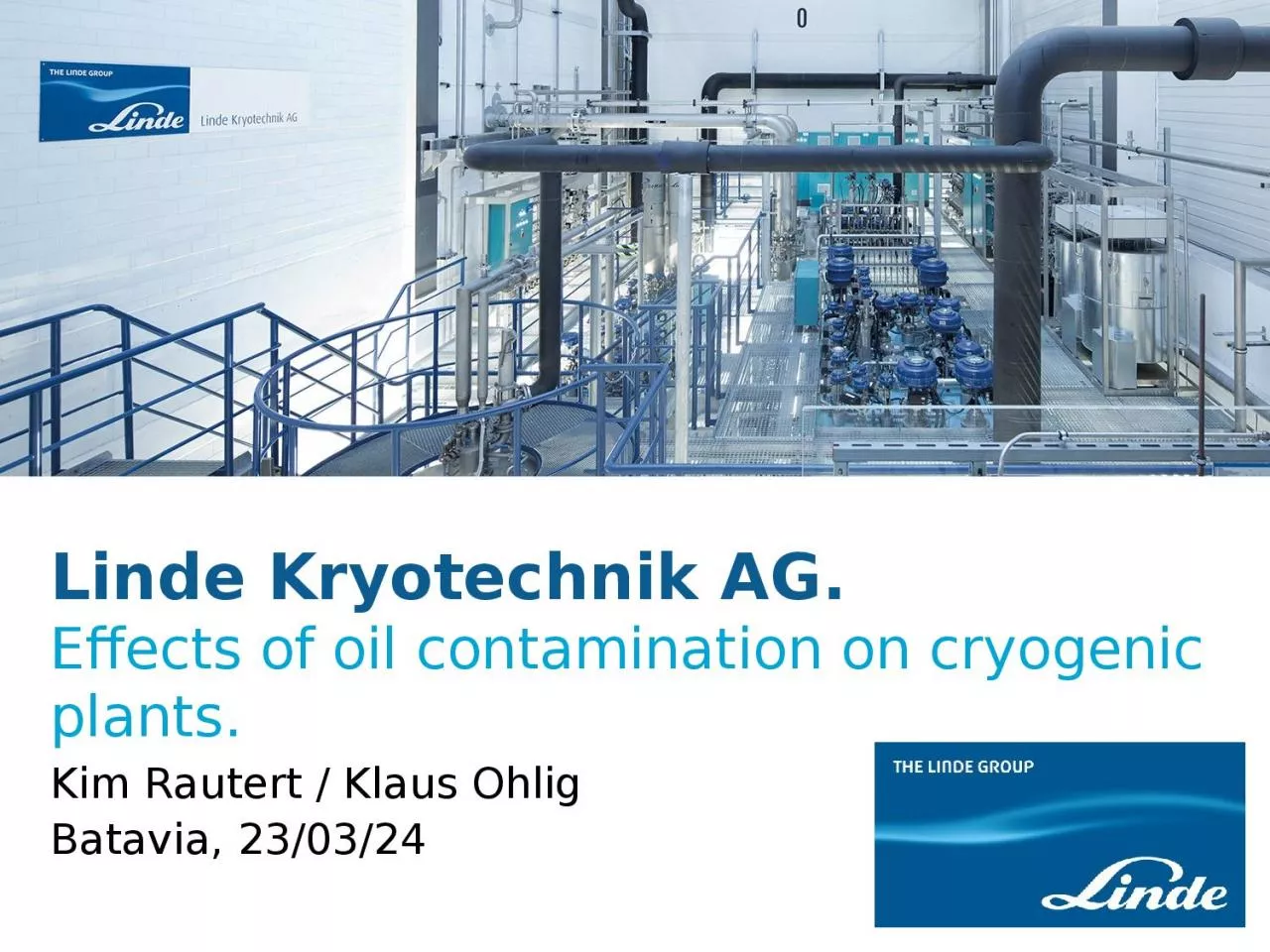

Kim Rautert Klaus Ohlig Batavia 24 October 2016 Basic o il contamination An oil lubricated screw compressor with 70 gs compressor mass flow operating 10 years continuously with 10 ppbw after oil removal system pushes 220 gram oil inside the ID: 1032861
Download Presentation The PPT/PDF document "Linde Kryotechnik AG. Effects of oil con..." is the property of its rightful owner. Permission is granted to download and print the materials on this web site for personal, non-commercial use only, and to display it on your personal computer provided you do not modify the materials and that you retain all copyright notices contained in the materials. By downloading content from our website, you accept the terms of this agreement.
1. Linde Kryotechnik AG.Effects of oil contamination on cryogenic plants.Kim Rautert / Klaus OhligBatavia, 24 October 2016
2. Basic oil contamination. An oil lubricated screw compressor with 70 g/s compressor mass flow, operating 10 years continuously with 10 ppb(w) after oil removal system pushes ~220 gram oil inside the coldbox.70 g/s10 ppb(w)10 years~220 gram oil~6% loss of heattransfer-performanceOther oil sources:Turbine oil bearingsHigh pressure recovery compressorBackflow of vacuumpumps24/10/2016
3. Further oil contamination causes.Bypassed, missed or ignored maintenance intervals:Replacement of coalescer cartridgeReplacement of activated charcoalIncorrect mechanical service work for:Compressor (oil separator, other service components)Coalescer cartridges (bypass flow, missing gaskets)Condensate drain/ BEKOMAT (service kit, missing gaskets)Oil adsorber (incorrect filling quantity, loose fill )High compressor discharge temperature (viscosity)Low compressor discharge, P< 9bara: Adsorber retention time too short24/10/2016
4. Oil contamination effects.Performance losses:Heat exchanger surface gets coated by oil and loses heat transfer capacity, heat transfer of HP and LP gets misbalancedDamaged Turbines:Frozen oil vapor blocks turbine wheel → mechanical damages (broken blades)Bearings (axial & radial) get contaminated by oil through bearing or process gas → turbine operation properties change (start up delay) Defect 80/ 20K adsorber:Activated charcoal adsorbs oil → Nitrogen/ Hydrogen/ Neon adsorption capacity reduces10/24/2016
5. Oil contamination detection.Unexplainable performance losses Changed plant behavior, especially: sequence of turbine start up, operating temperatures of first heat exchanger10/24/2016Pyrolyzer / MKD measurementVisual detection by checking of:Oil adsorber outletInner process components: valve seats, turbines, filters, buffer vessels, instrument tubes and other
6. Oil contamination repair.Heat exchanger washed with cleaning solvent:Cleaning procedure is carried out with electrical grounded, air driven membrane pumpTypically two cleaning cycles (each 4-8 hours) with acetone are sufficientHeat exchangers have to be dried with hot nitrogen for several days afterwardsRe-welding of purging ports, reinstallation of temperature sensors, installation of super insulationPressure and leak testAfter coldbox is reassembled and transported to final position, additional pump and purge thru LN2 cold trap is recommended Warm piping: compressor discharge, GMP, coldbox interfaces (bearing gas, warm up line) and buffer vessels should be check and cleaned also10/24/2016
7. Coldbox oil cleaning.10/24/2016
8. Is there a safe way to......completely avoid oil carry-over into the coldbox?10/24/2016
9. Yes: Use ionic liquids in recycle gas compression.10/24/2016Ionic liquids (IL) are «liquid salts»:negligible vapor pressuretemperature resistantecologically friendlynon-toxicno degradation
10. Key physical properties of ionic liquids.Tests proved that ionic liquids can be used for helium recycle gas compression with:Similar temperature profiles in the compressorNo impact on compressor efficiency10/24/2016Ionic LiquidsOil (HCF 12)Viscosity @ 40°Cmm2/s38.443.2Viscosity @ 100°Cmm2/s7.47.4Densitykg/m31’313841Heat capacity @ 40°CJ/kg/K1’7722’553Heat capacity @ 100°CJ/kg/K1’9982’778
11. What are the advantages of ionic liquids?10/24/2016The negligible vapor pressure of Ionic Liquids allows to remove the adsorber and at least one coalescer of the «Oil Removal System».Higher overall efficiency due to higher inlet pressure at coldbox→ higher liquefaction or refrigeration rate at constant power consumptionNo risk of liquid or vapor carry-over into the coldboxReduced space requirementsReduced risk of leakage at ORSReduced overall costs
12. Summary.10/24/2016In cooperation with Kaeser, Linde Kryotechnik AG has developed helium recycle gas compressors operating with Ionic Liquids.This technology is now available for all plants offered by Linde Kryotechnik AG with Kaeser helium compressors.Collaborate.Innovate.Deliver.
13. Thank you for your attention.